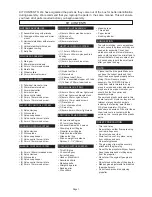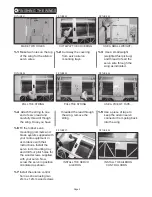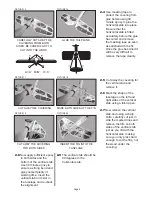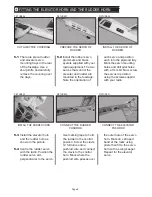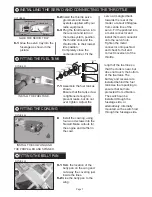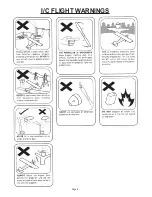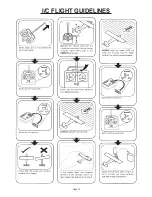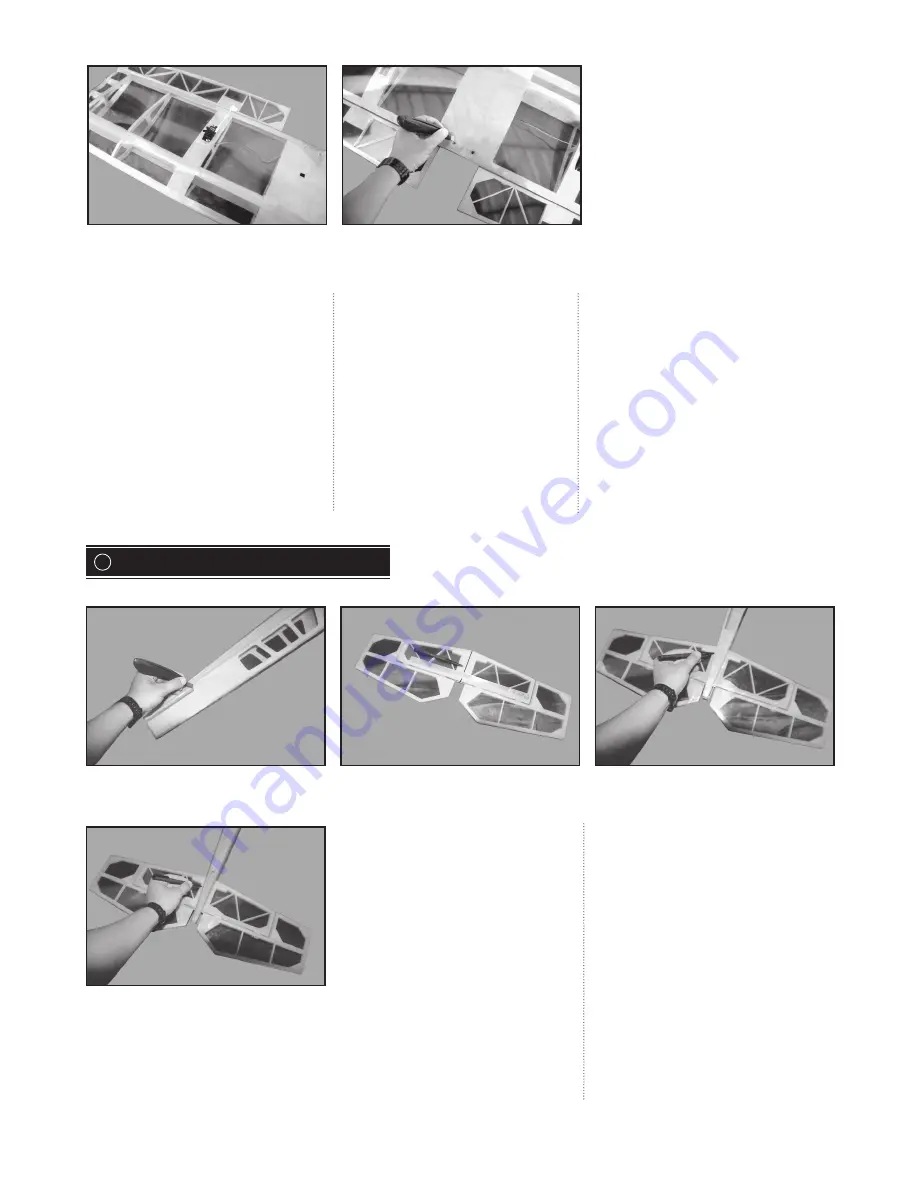
Instruction Manual
FUN STAR
Items required to complete and fly the Funstar
.40~.46 Two Stroke 48~.53 Four Stroke Model Engine and Propeller
4 Channel Proportional Radio Control System with five servos
Model Engine Fuel, Model Engine Starter and Glow Plug Battery
Hand Tools and Adhesives
SPECIFICATION
Wingspan
1340 mm (52.7 inches)
Length
1310 mm (51.5 inches)
Engine
40~.46 two stroke
48~.53 four stroke
Radio 4channel Servos 5 standard
Made in Vietnam
Page 1
KIT CONTENTS: We have organized the parts as they come out of the box for better identification
during assembly. We recommend that you regroup the parts in the same manner. This will ensure
you have all of parts required before you begin assembly.
AIRFRAME ASSEMBLIES
• (1) Assembled wing with ailerons
• (1) Fuselage with canopy and motor
mount
• (1) Horizontal stabilizer with elevator
halves
• (1) Vertical stabilizer with rudder
• (1) Fiberglass cowling
• (1) Belly Pan
MAIN GEAR ASSEMBLY
• (1) Main gear
• (2) 60mm diameter wheels
• (8) 3mm x 12mm wood screws
• (4) Metal strap
• (4) Wheel collars
• (4) 3mm x 6mm set screws
TAIL WHEEL ASSEMBLY
• (1) Tail wheel bracket w/ wire
• (1) 25mm diameter wheel
• (1) 2mm wheel collar
• (1) 4mm set screw
• (2) Nylon control clasp
• (2) 3mm x 12mm wood screw
• (2) 2mm x 10mm wood screw
ELEVATOR CONTROL SYSTEM
• (1) Nylon clevises
• (1) Silicone tube
• (1) Nylon snap keeper
• (1) Nylon control horn w/ plate
• (2) 2mm x 12mm wood screw
RUDDER CONTROL SYSTEM
• (1) Nylon clevises
• (1) Silicone tube
• (1) Nylon snap keeper
• (1) Nylon control horn w/ plate
• (2) 2mm x 12mm wood screw
AILERON CONTROL SYSTEM
• (2) 2mm x 180mm threaded wires
• (2) Nylon clevises
• (2) Silicone tube
• (2) Nylon snap keeper
• (2) Nylon control horn w/ plate
• (4) 2mm x 12mm wood screw
MOTOR MOUNT ASSEMBLY
• (4) 4mm x 25mm machine screws
• (8) 4mm nut
• (4) Lock washer
• (2) 8mm metal plate
THROTTLE CONTROL SYSTEM
• (1) 1,3mm x 500mm wire
• (1) 3,5mm x 350mm nylon pushrod
housing
• (1) Metal connector
• (1) 4mm x 4mm machine screw
FUEL TANK
• (1) Nylon fuel Tank
• (1) Metal clunk
• (1) Silicone tube/ 70mm
• (1) Pre - assembled stopper w/ 3 tube
• (1) 165mm x 250mm foam rubber
MISCELLANEOUS ITEMS
• (2) 4mm x 25mm x 98mm light wood
• (4) 15mm light wood triangle stock
• (4) 6mm x 45mm nylon screws
• (4) 3mm x 12mm wood screws
• (1) Decal sheet
• (1) Set of wire pushrod
• (1) Servo tray
• (2) 6mm x 6mm x 44mm light wood
ADDITIONAL ITEMS REQUIRED
• .46 two stroke Engine
• .53 four stroke Engine
• 4 channel Radio with 5 servos
• Glow plug to suit Engine
• Propeller to suit Engine
• Protective foam Rubber
• Silicone fuel line
• Stick on weight for balance
• Spinner: 2 - 1/4" (58mm)
TOOLS AND SUPPLIES NEEDED.
• Thick C/A glue
• 30 minute Epoxy
• 6 minute Epoxy
• Hand or Electric drill
• Assorted drill bits
• Modeling knife
• Straight edge ruler
• Bending plier
• Wire cutters
• Masking tape
• Thread lock
• Paper towels
• Rubbing alcohol
SUGGESTION
To avoid scratching your new airplane,
do not unwrap the pieces until they are
needed for assembly. Cover your
workbench with an old towel or brown
paper, both to protect the aircraft and to
protect the table. Keep a couple of jars
or bowls handy to hold the small parts
after you open the bag.
NOTE:
Please trial fit all the parts. Make sure
you have the correct parts and that
they fit and are aligned properly before
gluing! This will assure proper
assembly. The FUN STAR is hand
made from natural materials, every
plane is unique and minor adjustments
may have to be made. However, you
should find the fit superior and
assembly simple.
The paint and plastic parts used in this
kit are fuel proof. However, they are not
tolerant of many harsh chemicals
including the following: paint thinner,
C/A glue accelerator, C/A glue
debonder and acetone. Do not let these
chemicals come in contact with the
colors on the covering and the plastic
parts.
SAFETY PRECAUTION:
• This is not a toy
• Be sure that no other flyers are using
your radio frequency
• Do not smoke near fuel
• Store fuel in a cool, dry place, away
from children and pets
• Wear safety glasses
• The glow plug clip must be securely
attached to the glow plug
• Do not flip the propeller with your fingers
• Keep loose wires and clothing away
from the propeller
• Do not start the engine if people are
near
• Do not stand on the side of the propeller
• Make engine adjustments from behind
the propeller only
• Do not reach around the spinning
propeller
KIT CONTENTS
A=A’ B=B’ C=C’
GLUE THE TAILPLANE
CAREFULLY CUT AWAY THE
COVERING FROM BOTH
SIDES, BE CAREFUL NOT TO
CUT INTO THE WOOD
CUT AWAY THE COVERING
MARK BOTH SIDES OF THE FIN
CUT AWAY THE COVERING
FOR BOTH SIDES
INSERT THE FIN INTO THE
FUSELAGE
PICTURE 15
PICTURE 16
PICTURE 17
PICTURE 18
PICTURE 19
PICTURE 20
2.8
Now apply sufficient epoxy
to both sides and the
bottom of the vertical stab.
Use 30 minute epoxy to
ensure a strong bond and
give yourself plenty of
working time. Insert the
vertical stab in its slot in
the fuselage and re-check
the alignment.
2.9
The vertical stab should be
90 degrees to the
horizontal stab.
2.4
Use masking tape to
protect the covering from
glue before using 30
minute epoxy to glue the
horizontal stab into place.
Be sure that the
horizontal stab is fitted
accurately before the glue
has cured and remove
the masking tape as soon
as satisfied with the fit.
Once the glue has dried it
will be very difficult to
remove the tape cleanly.
2.5
Cut away the covering for
the vertical stab and
remove it.
2.6
Mark the shape of the
fuselage on the left and
right sides of the vertical
stab using a felt-tip pen.
2.7
Now remove the vertical
stab and using a sharp
knife, carefully cut just in
side the marked lines and
remove the film on both
sides of the vertical stab,
just as you did with the
horizontal stab, making
sure you only press hard
enough to cut the film, not
the wood under the
covering.
Page 4
Page 9
I/C FLIGHT WARNINGS
Page 10
I/C FLIGHT GUIDELINES
Page 2
USE A SMALL WEIGHT...
PULL THE STRING
MAKE TWO HOLES
CUT AWAY THE COVERING
PULL THE STRING
USE A PICE OF TAPE...
INSTALL THE AILERON
CONTROL HORN
INSTALL THE SERVO
AILERON
FINISHING THE WINGS
PICTURE 01
PICTURE 02
PICTURE 03
PICTURE 04
PICTURE 05
PICTURE 06
PICTURE 07
PICTURE 08
1.1
Make two holes on the top
of the wing for the aileron
servo wires.
1.2
Cut away the covering
from servo aileron
mounting trays.
1.4
Attach the string to one
end of servo lead and
carefully thread it though
the wing. Once you have
1.5
Use a piece of tape to
keep the aileron servo
connector from going back
into the wing.
1.6
Fit the rubber servo
mounting grommets and
brass eyelets supplied with
your radio equipment in
accordance with their
instructions. Install the
servo in its mounting tray
and drill four pilot holes for
the wood screws supplied
with your servo. Now,
screw the servo in position
orientated as shown.
1.7
Install the aileron control
horn as shown using two
2mm x 12mm wood screws
threaded the lead through
the wing, remove the
string.
1.3
Use a small weight
(weighted fuel pick-up)
and thread to feed the
servo wire through the
wing as indicated.
1
Page 3
DRAW A CENTER LINE
CUT AWAY THE COVERING
MARK THE TAILPLANE
MARK THE TAILPLANE
FITTING THE TAILPLANE
MAKE TWO HOLES
INSTALL THE AILERON
PUSHROD
PICTURE 09
PICTURE 11
PICTURE 14
PICTURE 12
PICTURE 13
PICTURE 10
1.8
Locate the two short
threaded pushrods, nylon
clevises, silicone tubes
and snap keepers. Screw
a clevis 12 full turns onto a
pushrod wire. Connect the
clevises to the control horn
on the aileron. Hold the
aileron in the natural
position using pieces of
masking tape.
Using pliers, bend the wire
in an L shape and connect
it to the servo arm. Install
the snap keeper to secure
the wire to the servo arm.
Using wire cutters, cut off
the excess wire. When
fitting any of the clevises to
the pushrod ensure that the
threaded end of the
pushrod is screwed into the
clevis by at lease 6mm (1/4).
1.9
Complete the aileron
linkage by slipping a 5mm
length of silicone tubing
over each clevis.
1.10
Cut away the covering as
shown.
Connect the servo to your
radio system and centre
the servo with the aileron
trim lever centered on the
transmitter. With the
aileron and the servo arm
in the neutral position,
mark where the aileron
pushrod passes the outer
hole in the servo arm.
2.1
Cut away the covering for
the Horizontal stab and
remove it.
2.2
Check the fit of the
horizontal stab in its slot.
Make sure the tail is
square and centered to the
fuselage by taking
measurements as shown
in the diagram, but don’t
glue anything yet. Check
that the horizontal stab is
parallel to the wing.
2.3
With the tail correctly
aligned, mark the shape of
the fuselage on the top and
bottom of the horizontal
stab using a water
soluble/non-permanent
felt-tip pen as shown here.
Cut away the covering
from both sides of the stab
just in side the lines. Be
careful not to cut into the
wood under the covering.
2
Fit the engine to the engine
mount with the screws,
lock washers, nuts and
metal plates provided.
Be sure the screws are
tight, a thread lock
compound may also be
used to avoid vibration
loosening the screws.
Page 5
FITTING THE LANDING GEAR
ACCESSORIES FOR LANDING
GEAR
THE WHEEL
INSTALL THE LANDING GEAR
INTO THE FUSELAGE
INSTALL THE TAIL WHEEL
INTO THE FUSELAGE
TWO STROKE
FOUR STROKE
INSTALL THE ENGINE
FITTING THE ENGINE
Down thrust 2
0
Right thrust 2
0
PICTURE 21
PICTURE 22
PICTURE 23
PICTURE 25
PICTURE 24
3.1
Prepare the accessories
for landing gear.
3.2
Install the wheel as shown.
3.3
Install the landing gear
onto the fuselage as
shown.
3.4
Install the tail wheel onto
the fuselage as shown.
Locate the long piece of
wire and plastic tube used
for the throttle pushrod.
One end of the wire has
been pre-pent into a “Z” -
bend at the factory.
This “Z” - bend should be
inserted into the throttle
arm of the engine as the
engine is fitted onto the
engine mount.
3
4
Page 6
CUT AWAY THE COVERING
INSTALL THE SERVO OF
RUDDER
PREPARE THE SERVO OF
RUDDER
INSTALL THE RUDDER HORN
CONNECT THE ELEVATOR
PUSHROD
CONNECT THE RUDDER
PUSHROD
FITTING THE ELEVATOR HORN AND THE RUDDER HORN
PICTURE 26
PICTURE 27
PICTURE 28
PICTURE 29
PICTURE 30
PICTURE 31
5.1
There are precut rudder
and elevator servo
mounting trays in the rear
of the fuselage. Use a
sharp knife and carefully
remove the covering over
the trays.
5.2
Install the rubber servo
grommets and brass
eyelets supplied with your
radio equipment. The two
servos that control the
elevator and rudder are
mounted in the fuselage.
Note the orientation of
each servo and position
each into the plywood tray.
Mark the servo mounting
holes and drill pilot holes
with a 1mm bit. Now screw
the servos in position
using the screws supplid
with your radio.
5.3
Install the elevator horn
and the rudder horn as
shown in the picture.
5.4
Centre the rudder servo
with the radio. Position the
rudder servo arm
perpendicular to the servo.
Use marking tape to hold
the rudder in the central
position. Screw the clevis
12 full turns onto a
pushrod wire and connect
the clevis to the control
horn. Mark where the
pushrod wire passes over
the outer hole of the servo
horn. Mark an L shaped
bend at the mark using
pliers then fit to the servo
horn with a swing keeper.
Repeat for the elevator
servo.
5
Page 8
ELEVATOR : 25mm up
25mm down
RUDDER : 50mm right
50mm left
AILERON : 20mm up
20mm down
RADIO CONTROL AND CONTROL SURFACE THROWS
BALANCE YOUR MODEL
PRE-FLIGHT CHECK
WARNING
CG
Metric Conversions
0
10 20 30 40 50 60 70 80 90 100 110 120 130 140 150 160 170 180
7"
6"
5"
4"
3"
2"
1"
0"
Inch Scale
Metric Scale
Inches x 25.4 = mm (conversion factor)
1/64" =
.4 mm
3/16" = 4.8 mm
1" = 25.4 mm
21" = 533.4 mm
1/32" =
.8 mm
1/4" =
6.4 mm
2" = 50.8 mm
24" = 609.6 mm
1/16" = 1.6 mm
3/8" =
9.5 mm
3" = 76.2 mm
30" = 762.0 mm
3/32" = 2.4 mm
1/2" = 12.7 mm
6" = 152.4 mm
36" = 914.4 mm
1/8" = 3.2 mm
5/8" = 15.9 mm
12" = 304.8 mm
5/32" = 4.0 mm
3/4" = 19.0 mm
18" = 457.2 mm
We wish you many enjoyable flights with your plane and once again
thank you for your choosing Phoenix Model's product.
100-120 mm
This model should not be flown as
high speeds using high power
settings or the control surfaces may
flutter and cause the airplane to
crash. Full power should only be
used on vertical flight, and should
only be used when absolutely
necessary. Full throttle straight and
level flight, or diving flight, will
result in flutter and damage to the
airplane, possibly causing a crash
and/ or damage to the servos.
12.1
Completely charge your
transmitter and receiver
batteries before your first
day of flying.
12.2
Check every bolt and
every glue joint in your
model to ensure
everything is tight and well
bonded.
12.3
Check that silicone tubes
used for clevis retainers
are in place.
12.4
Double check the
balance of the airplane. Do
this before filling the tank
with fuel.
11.1
This section is very
important and must not be
obmitted ! A model that is
not properly balanced will
be unstable and possibly
unflyable.
11.2
The Balance Point is
100-120mm back from the
leading edge of the wing.
Assemble the model and
use masking tape to mark
the balance point. Lift the
model at the marks, if the
nose of the model falls, it
is nose heavy. If the tail of
the model falls, it is tail
heavy. To correct this, try
moving the battery pack.
If this is not enough, add
ballast weight as
necessary.
10
We recommend the
following control surface
throws:
12.5
Check the control
surfaces. All should move
in the correct direction and
not bind in any way.
12.6
Check the receiver
antenna. It should be fully
extended and not still
coiled up in the fuselage.
10
11
12
Page 7
FITTING THE FUEL TANK
INSTALL THE FUEL TANK
INSTALL THE COWLING AND
THE PROPELLER AND SPINNER
FITTING THE COWLING
FITTING THE BELLY PAN
INSTALLING THE SERVO AND CONNECTING THE THROTTLE
GLUE THE SERVO TRAY
PICTURE 32
PICTURE 33
PICTURE 34
PICTURE 35
6.1
Glue the servo tray into the
fuselage as shown in the
picture.
6.2
Install the throttle servo
grommets and brass
eyelets supplied with your
radio equipment.
6.3
Plug the throttle servo into
the receiver and turn on
the radio system, position
the throttle stick and the
throttle trim to their lowest
idle position.
Completely close the
carburator barrel. Fit the
7.1
Assemble the fuel tank as
shown.
Ensure that the tank screw
is tightened enough to
prevent leaks, but do not
over tighten. Adjust the
servo arm angled back
towards the rear of the
model, at about 45degree
from centre line of the
servo. Fit the pushrod into
a metal connector and
install the metal connector
onto the servo horn.
Tighten the metal
connector onto pushrod
and check for full and
correct movement of the
throttle.
8
Install the cowling, using
four wood screws into the
firewall. Make cutouts for
the engine and muffler in
the cowl.
9.1
Mark the location of the
belly pan on the wing and
cut away the covering just
inside the lines.
9.2
Glue the belly pan to the
wing.
length of the fuel line so
that the clunk is near, but
does not touch, the bottom
of the fuel tank. The
battery and receiver are
installed behind the fuel
tank.Use foam packing to
ensure that both are
protected from vibration.
The switch can be
installed through the
fuselage side, or
alternatively, internally
mounted, with a switch rod
through the fuselage side.
Throttle servo
Antenna exit
Battery
Receiver
6
7
8
9
Summary of Contents for Fan Star
Page 2: ......
Page 11: ...Page 9 I C FLIGHT WARNINGS 80 ...
Page 12: ...Page 10 I C FLIGHT GUIDELINES ...



